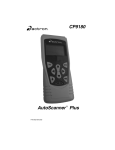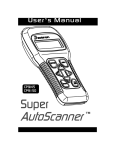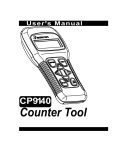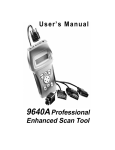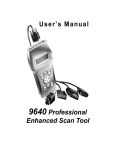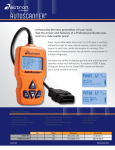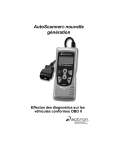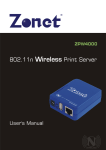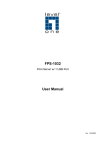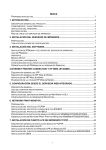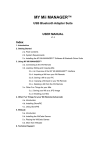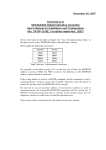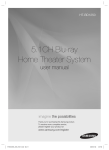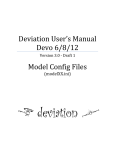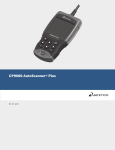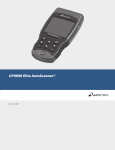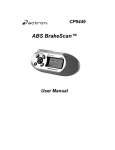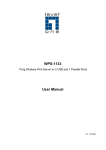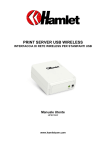Download Next Generation Do it Yourself AutoScanner®
Transcript
Next Generation Do it Yourself AutoScanner® Performs diagnostics on OBD II compliant vehicles Instructions in English, Spanish, and French Instrucciones en Inglés, Español, y Francés Instructions en Anglais, Espagnol, et les Français 15825 Industrial Parkway Cleveland Ohio 44135 USA (EUA) Tool Information Complete the following list. Provide this information when contacting customer support. Serial No: SW ID: Refer to section 4.7 to get the Serial Number (Serial No) and Software Identification (SW ID.) If you have questions or concerns Contact Technical Support: • Phone: 1-800-228-7667 • Web Site: www.actron.com • Mail: SPX Service Solutions 15825 Industrial Parkway Cleveland, Ohio 44135 Copyright Information Copyright © 2005 SPX Corporation All rights reserved. The information, specifications and illustrations in this guide are based on the latest information available at the time of printing. SPX Corporation reserves the right to make changes at any time without notice. Table of Contents Safety Precautions SF1-SF10 Section 1 - Getting Started Using CD . . . . . . . . . . . . . . . . . . . . . . . . . . . . . . . . . . . . . . . . . . . 1-2 Running Applications On Included CD . . . . . . . . . . . . . . . . . . . 1- 3 Vehicle Service Information . . . . . . . . . . . . . . . . . . . . . . . . . . . 1-4 Introduction to On-Board Diagnostics . . . . . . . . . . . . . . . . . . . 1-6 SAE Publications . . . . . . . . . . . . . . . . . . . . . . . . . . . . . . . . . . . 1-6 Data Link Connector (DLC) . . . . . . . . . . . . . . . . . . . . . . . . . . . . 1-7 Diagnostic Trouble Codes (DTCs) . . . . . . . . . . . . . . . . . . . . . . 1-8 Section 2 - AutoScanner ® Specifications & Power Information The AutoScanner® Keypad Configuration . . . . . . . . . . . . . . . . . Specifications . . . . . . . . . . . . . . . . . . . . . . . . . . . . . . . . . . . . . . Included with AutoScanner ® . . . . . . . . . . . . . . . . . . . . . . . . . . Display . . . . . . . . . . . . . . . . . . . . . . . . . . . . . . . . . . . . . . . . . . . Keypad . . . . . . . . . . . . . . . . . . . . . . . . . . . . . . . . . . . . . . . . . . . Power . . . . . . . . . . . . . . . . . . . . . . . . . . . . . . . . . . . . . . . . . . . . . . Internal Battery . . . . . . . . . . . . . . . . . . . . . . . . . . . . . . . . . . . . . Vehicle Power . . . . . . . . . . . . . . . . . . . . . . . . . . . . . . . . . . . . . 2-1 2-2 2-2 2-3 2-3 2-4 2-4 2-5 Section 3 - Using AutoScanner ®: Diagnostic Trouble Codes (DTCs) and Data Read Codes . . . . . . . . . . . . . . . . . . . . . . . . . . . . . . . . . . . . . . . . . 3-1 Erase Codes . . . . . . . . . . . . . . . . . . . . . . . . . . . . . . . . . . . . . . . . 3-3 MIL (Malfunction Indicator Lamp) Status . . . . . . . . . . . . . . . . . 3-6 I/M Monitors (Emissions Systems) . . . . . . . . . . . . . . . . . . . . . . 3-7 View Freeze Data . . . . . . . . . . . . . . . . . . . . . . . . . . . . . . . . . . . . 3-9 Review . . . . . . . . . . . . . . . . . . . . . . . . . . . . . . . . . . . . . . . . . . . . 3-11 Code Lookup . . . . . . . . . . . . . . . . . . . . . . . . . . . . . . . . . . . . . . 3-12 Section 4 - System Setup / Test System Setup . . . . . . . . . . . . . . . . . . . . . . . . . . . . . . . . . . . . . . . . . . . . 4-1 Adjusting Display Contrast . . . . . . . . . . . . . . . . . . . . . . . . . . . . . . . . . 4-2 Language Setup . . . . . . . . . . . . . . . . . . . . . . . . . . . . . . . . . . . . . . . . . 4-3 Display Test . . . . . . . . . . . . . . . . . . . . . . . . . . . . . . . . . . . . . . . . . . . . 4-4 Keypad Test . . . . . . . . . . . . . . . . . . . . . . . . . . . . . . . . . . . . . . . . . . . . 4-5 Memory Test . . . . . . . . . . . . . . . . . . . . . . . . . . . . . . . . . . . . . . . . . . . . 4-6 Tool Information . . . . . . . . . . . . . . . . . . . . . . . . . . . . . . . . . . . . . . . . . 4-7 Program Mode . . . . . . . . . . . . . . . . . . . . . . . . . . . . . . . . . . . . . . . . . . 4-8 Section 5 - Troubleshooting Error Messages . . . . . . . . . . . . . . . . . . . . . . . . . . . . . . . . . . . . . . . . . . . 5-1 Tool Does Not Power Up . . . . . . . . . . . . . . . . . . . . . . . . . . . . . . . . . . . 5-1 Operating Error or Erroneous Data . . . . . . . . . . . . . . . . . . . . . . . . . . . 5-2 Glossary Global PID’s Warranty & Repair A1-A11 B1-B3 Safety Precautions For safety, read, understand and follow all safety messages and instructions in manual and on test equipment before operating tool. Always refer to and follow safety messages and test procedures provided by manufacturer of vehicle and tools. Safety messages below and throughout this manual are reminders to use caution when using tool. Safety Messages Safety messages are provided to help prevent personal injury and equipment damage. Safety messages in this section of the manual have a signal word with a 3 part message and, in some cases, an icon. The signal word indicates the level of the hazard. Signal Words Used: ! DANGER Indicates a possible hazardous situation which, if not avoided, will result in death or serious injury to operator or bystanders. ! WARNING Indicates a possible hazardous situation which, if not avoided, could result in death or serious injury to operator or bystanders. ! CAUTION Indicates a possible hazardous situation which, if not avoided, may result in moderate or minor injury to operator or bystanders. IMPORTANT Indicates a condition which, if not avoided, may result in damage to test equipment or vehicle. SF-1 Type Styles Used: Normal type states hazard. Bold type states how to avoid hazard. Italic type states possible results of not avoiding hazard. Icons used: An icon, when present, gives a graphical description of possible hazard. Example: Engine systems can malfunction spilling fuel, oil vapors, hot steam, hot toxic exhaust gases, acid, refrigerant and other debris. • Wear safety goggles and protective gloves - User and bystander - Even if your everyday glasses have impact resistant lenses, they may NOT be safety glasses, and may not provide adequate protection. Engine systems that malfunction can cause injury. Important Safety Messages Risk of electric shock. • Do not exceed voltage limits between inputs indicated in “Specifications.” • Use extreme caution when working with circuits that have greater than 60 volts DC or 24 volts AC. Electric shock can cause injury. SF-2 Risk of explosion. ! WARNING • Wear safety goggles and protective clothing. - User and bystander - Even if your everyday glasses have impact resistant lenses, they may NOT be safety glasses, and may not provide adequate protection. • Do not use Tool in environments where explosive vapors may collect. - As in below-ground pits, confined areas, or areas that are less than 18 inches above floor. • Use Tool in locations with mechanical ventilation providing at least 4 air changes per hour. • Flammable fuel and vapors can ignite. • Do not smoke, strike a match, or cause a spark in vicinity of battery. Battery gases can ignite. • Avoid making accidental connection between battery terminals. - Do not place uninsulated metal tools on battery. • When removing battery cables, remove ground cable first. • Avoid sparks when connecting or disconnecting power leads to battery. • Make sure ignition is OFF, headlights and other accessories are OFF and vehicle doors are closed before disconnecting battery cables. - This also helps prevent damage to on-board computer systems. • Always disconnect battery ground connections before servicing electrical system components. Explosion can cause injury. SF-3 ! WARNING Risk of poisoning. • Use Tool in locations with mechanical ventilation providing at least 4 air changes per hour. Engine exhaust contains odorless lethal gas. • Route exhaust outside while testing with engine running. Poisoning can result in death or serious injury. ! WARNING Battery acid is a highly corrosive sulfuric acid. • Wear safety goggles and protective gloves. - User and bystander - Even if your everyday glasses have impact resistant lenses, they may NOT be safety glasses, and may not provide adequate protection. • Make sure someone can hear or is close enough to provide aid when working near a battery. • Have plenty of fresh water and soap nearby. - If battery acid contacts skin, clothing, or eyes, flush exposed area with soap and water for 10 minutes. - Seek medical help. • Do not touch eyes while working near battery. Battery acid can burn eyes and skin. SF-4 Risk of fire. • Wear safety goggles and protective clothing. - User and bystander - Even if your everyday glasses have impact resistant lenses, they may NOT be safety glasses, and may not provide adequate protection. • Do not position head directly over or in front of throttle body. • Do not pour gasoline down throttle body when cranking or running engine, when working with fuel delivery systems or any open fuel line. - Engine backfire can occur when air cleaner is out of position. • Do not use fuel injector cleaning solvents when performing diagnostic testing. • Keep cigarettes, sparks, open flame and other sources of ignition away from vehicle. • Keep a dry chemical (Class B) fire extinguisher rated for gasoline, chemical and electrical fires in work area. Fire can cause death or serious injury. Risk of flying particles. • Wear safety goggles while using electrical equipment. - Electrical equipment or rotating engine parts can cause flying particles. - Even if your everyday glasses have impact resistant lenses, they may NOT be safety glasses, and may not provide adequate protection. Flying particles can cause eye injury. SF-5 Risk of burns. • Batteries can produce a short-circuit current high enough to weld jewelry to metal. - Remove jewelry such as rings, bracelets and watches before working near batteries. Short circuits can cause injury. ! WARNING Risk of burns. • Do not remove radiator cap unless engine is cold. - Pressurized engine coolant may be hot. • Do not touch hot exhaust systems, manifolds, engines, radiators, sample probe, etc. • Wear insulated gloves when handling hot engine components. • Tester leads can become hot after extended testing in close proximity to manifolds etc. Hot components can cause injury. SF-6 Risk of spilling fuel, oil vapors, hot steam, hot toxic exhaust gases, acid, refrigerant and other debris. • Wear safety goggles and protective clothing - User and bystander - Even if your everyday glasses have impact resistant lenses, they may NOT be safety glasses, and may not provide adequate protection. • Engine systems can malfunction - Expelling fuel, oil vapors, hot steam, hot toxic exhaust gases, acid, refrigerant and other debris. Fuel, oil vapors, hot steam, hot toxic exhaust gases, acid, refrigerant and other debris can cause serious injury. Engine compartment contains electrical connections and hot or moving parts. • Keep personnel, test leads, clothing and other objects clear of electrical connections and hot or moving engine parts. • Do not wear watches, rings, or loose fitting clothing when working in an engine compartment. • Do not place tools on fenders or other places in engine compartment. • To help identify danger zones in test areas use barriers. • Prevent personnel from walking through test area. Contacting electrical connections and hot or moving parts can cause injury. SF-7 Risk of injury. • Only qualified personnel should operate tool. • Use tool only as described in guide. • Do not operate tool with damaged cords. • Do not operate tool if dropped or damaged, until examined by a qualified service representative. Operation of tool by anyone other than qualified personnel may result in injury. ! WARNING PRNDL2 Risk of unexpected vehicle movement. • Block drive wheels before performing a test with engine running. • Unless instructed otherwise: - set parking brake - put gear selector in neutral for standard transmissions - put gear selector in park for automatic transmissions - disconnect release mechanism on automatic parking brake release, for testing and reconnect when testing is completed. • Do not leave engine running unattended. A moving vehicle can cause injury. SF-8 ! CAUTION Risk of equipment or circuit damage. • Unless specifically directed by manufacturer, make sure ignition is OFF before connecting or disconnecting connectors or any vehicle electrical terminals. • Do not create a short between battery terminals with a jumper wire or tools. Improper equipment use can cause equipment or circuit damage. ! CAUTION Misdiagnosis may lead to incorrect or improper repair and/or adjustment. • Do not rely on erratic, questionable, or obviously erroneous test information or results. - Make sure all connections and data entry information are correct and test procedures performed right, if test information or results are erratic, questionable, or obviously erroneous. - If test information or results are still suspicious, do not use them for diagnosis. Improper repair and/or adjustment may cause vehicle or equipment damage or unsafe operation. SF-9 ! DANGER Some vehicles are equipped with air bags. • Follow vehicle service manual’s warnings when working around air bag components or wiring. - If service manual instructions are not followed, air bag may open unexpectedly, resulting in injury. - Note air bag can still open up several minutes after ignition key is off (or if vehicle battery is disconnected) because of a special energy reserve module. An air bag opening can cause injury. SF-10 Section 1 – Getting Started The Global OBD II AutoScanner ® was developed by experts in the automotive service industry to help diagnose vehicles and assist in troubleshooting procedures. AutoScanner ® monitors vehicle events and retrieves codes from vehicle’s control module to help pinpoint problem areas. All information, illustrations and specifications contained in this manual are based on the latest information available from industry sources at the time of publication. No warranty (expressed or implied) can be made for its accuracy or completeness, nor is any responsibility assumed by the manufacturer or anyone connected with it for loss or damages suffered through reliance on any information contained in this guide or misuse of accompanying product. The manufacturer reserves the right to make changes at any time to this guide or accompanying product without obligation to notify any person or organization of such changes. Getting Started 1-1 Using CD ✓ The Included CD is NOT required to operate AutoScanner ®. ✓ Some of the items included on the CD are: ❒ ❒ ❒ ❒ ✓ Manuals included with AutoScanner ®. DTC Lookup Software. Adobe Acrobat Reader. Other Product Information. To be able to use the included CD the PC must meet the following minimum requirements: ❒ ❒ ❒ ❒ ❒ ❒ ❒ 486 PC. 4 MB of RAM. Microsoft Windows 95 or Newer. CD ROM Drive. Adobe Acrobat Reader. Internet Explorer 4.0 or Newer. Screen Resolution of 800 x 600 – If screen resolution is 800 x 600, in Display Properties, Settings Tab, set Font Size to Small Fonts. 1-2 Getting Started Running Applications On Included CD 1.Close All Programs on Computer. 2.Place Included CD in CD-Drive. ✓ If CD does not start automatically; ❒ Select the Start button. ❒ Select Run... ❒ Enter “X:\Menu.Exe” in Open Box on Computer and select OK. ❒ “X” is the CD-ROM drive letter on the computer. 3.Observe Menu Appears. 4.Follow screen prompts on computer to run applications. Getting Started 1-3 Vehicle Service Information The following is a list of web sites and phone numbers where electronic engine control diagnostic information is available. ✓ 1-4 Some manuals may be available at your local dealer, auto parts stores or local public libraries Getting Started Web Site Phone Number Chevrolet Pontiac General Oldsmobile Motors Buick Cadillac Saturn Domestic Ford Vehicles Ford Lincoln Mercury Chrysler Dodge Chrysler Plymouth Eagle Audi Volkswagon BMW MINI Jaguar European Vehicles Volvo Mercedes Land Rover Porsche Saab Acura Honda Lexus Scion Toyota Hyundai Infiniti Nissian Asian Vehicles Kia Mazda Daewoo Subaru Isuzu Geo Mitsubishi Suzuki Chilton Book Company Other Manuals Haynes Publications Bentley Publishers www.chevrolet.com www.pontiac.com www.oldsmobile.com www.buick.com www.cadillac.com www.saturn.com www.ford.com www.lincoln.com www.mercury.com www.chrysler.com www.dodge.com Not Available Not Available www.audi.com www.vw.com www.bmw.com www.mini.com www.jaguar.com www.volvo.com www.mercedes-benz.com www.landrover.com www.porsche.com www.saab.com www.acura.com www.honda.com www.lexus.com www.scion.com www.toyota.com www.hyundai.com www.infiniti.com www.nissianusa.com www.kia.com www.mazda.com www.daewoo.com www.subaru.com www.isuzu.com Not Available www.mitsubishi.com www.suzukiauto.com www.chiltonsonline.com www.haynes.com www.bentleypublishers.com 1-800-551-4123 1-800-551-4123 1-800-551-4123 1-800-551-4123 1-800-333-4CAD 1-800-553-6000 1-800-392-3673 1-800-392-3673 1-800-392-3673 1-800-348-4696 1-800-348-4696 1-800-348-4696 1-800-348-4696 1-800-544-8021 1-800-544-8021 1-201-307-4000 1-201-307-4000 1-800-4-JAGUAR 1-800-458-1552 1-800-367-6372 1-800-637-6837 1-800-PORSCHE 1-800-955-9007 1-800-999-1009 1-800-999-1009 1-800-255-3987 1.866.70.SCION 1-800-GO-TOYOTA 1-800-633-5151 1-800-662-6200 1-800-nissian1 1-800-333-4542 1-800-222-5500 1-822-759-2114 1-800-SUBARU3 1-800-255-6727 Not Available 1-888-MITSU2004 1-800-934-0934 1-800-347-7707 1-800-242-4637 1-800-423-4595 Repair Information Mitchell Programs www.mitchell1.com 1-888-724-6742 Suitable Manual Titles Getting Started ALLDATA www.alldata.com “Diagnostic Service Manuals” “PowerTrain Codes and Oxygen Sensors” “Automotive Emission Control Manual” “Fuel Injection” “Automotive Electrical Manual” “Automotive Electrics and Electronics” “Automotive Sensors” “Electronic Transmission Control” “Emission Control Technology “Engine Management” or similar titles... 1-800-697-2533 1-5 Introduction to On-Board Diagnostics OBD II (On-Board Diagnostics version II) is a system that the Society of Automotive Engineers (SAE) developed to standardize automotive electronic diagnosis. Beginning in 1996, most new vehicles sold in the USA were OBD II compliant. ✓ Technicians now can use the same tool to test any OBD II compliant vehicle without special adapters. SAE established guidelines that provide: ❒ A universal connector, called the Data Link Connector (DLC), with dedicated pin assignments. ❒ A standard location for the Data Link Connector (DLC), visible under the dash on driver’s side. ❒ A standard list of diagnostic trouble codes (DTCs) used by all manufacturers. ❒ A standard list of parameter identification (PID) data used by all manufacturers. ❒ Ability for vehicle systems to record operating conditions when fault occurs. ❒ Expanded diagnostic capabilities that records a code whenever a condition occurs that affects vehicle emissions. ❒ Ability to clear stored codes from vehicles memory with Tool. SAE Publications SAE has published hundreds of pages of text defining a standard communication protocol that establishes hardware, software, and circuit parameters of OBD II systems. • SAE publishes recommendations, not laws, but the Environmental Protection Agency (EPA) and California Air Resources Board (CARB) made many of SAE’s recommendations legal requirements. 1-6 Getting Started Data Link Connector (DLC) The AutoScanner ® uses a Data Link Connector (DLC) to communicate with the vehicle’s control module. ✓ Data Link Connector Location. ❒ Under dashboard on driver side of vehicle. ❒ If Data Link Connector is not located under dashboard, a label should be there telling where the connector can be found. Data Link Connector (DLC) Pins 1 - Manufacturer Reserved 2 - J1850 Bus+ 3 - Manufacturer Reserved 4 - Chassis Ground 5 - Signal Ground 6 - CAN High, J-2284 7 - K Line, ISO 9141-2 & ISO/DIS 14230-4 8 - Manufacturer Reserved 9 - Manufacturer Reserved 10 - J1850 Bus11 - Manufacturer Reserved 12 - Manufacturer Reserved Getting Started 1 8 9 16 13 - Manufacturer Reserved 14 - CAN Low, J-2284 15 - L Line, ISO 9141-2 & ISO/DIS 14230-4 16 - Battery Power 1-7 Diagnostic Trouble Codes (DTCs) ✓ Diagnostic Trouble Codes help determine the cause of a problem or problems with a vehicle. ❒ Diagnostic Trouble Codes (DTCs) consist of a five-digit alphanumeric code. ❒ The Diagnostic Trouble Codes format and general code types are shown below. Bx - Body Cx - Chassis Px - Powertrain Ux - Network Comm. x = 0, 1, 2 or 3 P0 1 0 1 Specific Fault Designation Vehicle Specific System Example: P0101 - Mass or Volume Air Flow Circuit Range/Performance Problem Powertrain Codes P0xxx - Generic (SAE) P1xxx - Manufacturer Specific P2xxx - Generic (SAE) P30xx-P33xx - Manufacturer Specific P34xx-P39xx - Generic (SAE) Chassis Codes C0xxx - Generic (SAE) C1xxx - Manufacturer Specific C2xxx - Manufacturer Specific C3xxx - Generic (SAE) 1-8 Getting Started Body Codes B0xxx - Generic (SAE) B1xxx - Manufacturer Specific B2xxx - Manufacturer Specific B3xxx - Generic (SAE) Network Communication Codes U0xxx - Generic (SAE) U1xxx - Manufacturer Specific U2xxx - Manufacturer Specific U3xxx - Generic (SAE) Within each category (Powertrain, Chassis, Body and Network) of Diagnostic Trouble Codes there are assigned ranges for different vehicle systems. Lower Upper Assigned DTC System P0000 P0100 P0300 P0400 P0500 P0600 P0700 P0A00 P1000 P1100 P1300 P1400 P1500 P1600 P1700 P2000 P2300 P2400 P2500 P2600 P2700 P2900 P3300 P3400 U0000 U0100 U0300 U0400 P00FF P02FF P03FF P04FF P05FF P06FF P09FF P0AFF P10FF P12FF P13FF P14FF P15FF P16FF P19FF P22FF P23FF P24FF P25FF P26FF P27FF P32FF P33FF P34FF U00FF U02FF U03FF U04FF ✓ Fuel Air Metering Auxiliary Emission Controls Fuel Air Metering Ignition System or Misfire Auxiliary Emission Controls Vehicle Speed Idle Control Auxiliary Inputs Computer and Auxiliary Outputs Transmission Hybrid Propulsion Manufacturer Control Fuel & Air Metering, Auxiliary Emission Controls Manufacturer Control Fuel & Air Metering Manufacturer Control Ignition System or Misfire Manufacturer Control Auxiliary emission Controls Manufacturer Cntrl Veh.Spd. Idle Speed Control Auxiliary Inputs Manufacturer Control Auxiliary Inputs Auxiliary Outputs Manufacturer Control Transmission Fuel Air Metering Auxiliary emission Controls Ignition System or Misfire Auxiliary Emission Controls Auxiliary Inputs Computer and Auxiliary Outputs Transmission Fuel Air Metering Auxiliary Emission Controls Ignition System Cylinder Deactivation Network Electrical Network Communication Network Software Network Data J2012 and ISO 15031-6 are standards for all Diagnostic Trouble Codes, established by the SAE, International Organization for Standardization (ISO) and other governing bodies. ❒ Codes and definitions assigned by these specifications are known as Generic OBD II codes. ❒ OBD II requires compliance to these standards, for all cars, light trucks, APVs, MPVs, and SUVs sold in the U.S. ❒ Codes not reserved by SAE are manufacturer reserved and referred to as Manufacturer Specific Codes. Getting Started 1-9 1-10 Getting Started Section 2 – AutoScanner ® Specifications & Power Information The AutoScanner ® Keypad Configuration B C d e f g h i J a b LCD Display – 128 x 64 graphic display with contrast adjust. UP arrow key – moves UP through functions and picks YES on questions requiring a yes or no answer. ENTER key – selects displayed items. DOWN arrow key – moves DOWN through functions and picks NO on questions requiring a yes or no answer. BACK key – usually returns to previous screen or DIAGNOSTIC MENU and cancels the prior selection. ERASE hot key – used to run the Erase function. POWER key – turns power ON or OFF when disconnected from vehicle. OBDII Cable – provides connection for vehicle interface. Serial Port – gives a way to get 9 2 3 on top 1 4 8 7 6 5 10 upgrades for the AutoScanner ®. Serial Number Plate – (On Back) shows serial number. Battery Compartment – provides power to AutoScanner ® for upgrading or reviewing codes off-vehicle. 11 AutoScanner ® Specifications & Power Information 2-1 ••••••••••••••••••••••••••••••••••••••••••••••••••••••••• 2–1 Specifications Display: 128 x 64 pixel display with contrast adjust. Operating Temperature: 0 to 50°C (32 to 122°F) Storage Temperature: -20 to 70°C (-4 to 158°F) External Power: 7 to 16 Volts ✓ A minimum of 8.0 V is required for most control modules to operate properly in a vehicle. Power Dissipation: 5 Watts maximum Dimensions: Thickness 1.125" 28.6 mm Width 3.25" 82.6 mm Length 7.75" 196.9 mm Included with AutoScanner ® Part Manual CD Product Registration ✓ Part Description Used to give an understanding on how to operate the tool. The CD includes: - DTC Lookup Software - for looking up DiagnosticTrouble Codes. - Manual - Other Product Information Used to Register Tool for troubleshooting concerns and updating tool. Part Number 0002-2826 1000-5287 0002-2306 Replacement Parts are available from the manufacturer by contacting customer service. • Phone: 1-800-228-7667 (8:00 - 6:00 EST Monday - Friday) 2-2 AutoScanner ® Specifications & Power Information Display The display has a large viewing area displaying messages, instructions, and diagnostic information. ✓ The Liquid Crystal Display (LCD) is a 128 x 64 pixel display. ❒ Characters used to help operate AutoScanner ® are: Indicates current selection. Indicates additional information is available on previous screen. Indicates additional information is available on next screen. Pending Indicates the code is a pending code. Refer to the Read Codes Section for more details. Er Appears if the ERASE hot key is available. Indicates to install or replace the internal battery soon. Keypad The keypad is used to move through the different menus of the AutoScanner ®. ! CAUTION Do not use solvents such as alcohol to clean keypad or display. Use a mild nonabrasive detergent and a soft cotton cloth. ! CAUTION Do not soak keypad as water might find its way inside the AutoScanner ®. AutoScanner ® Specifications & Power Information 2-3 Power Internal Battery ✓ The Internal Battery allows the operator to Review Data or look up Diagnostic Trouble Code definitions without being connected to a vehicle. ✓ Refer to “Tool Does Not Power Up” if there are problems. ✓ When the tool is not connected to the vehicle the POWER key turns tool ON and OFF. POWER key for at least 1 second to turn ON AutoScanner ®. ENTER ❒ Press and hold ERASE ✓ When powered from the internal battery, AutoScanner ® turns OFF after a period of inactivity. ✓ The AutoScanner ® checks the internal battery when turning on tool. ❒ If voltage is low, Low MENU DE DIAGNOSTIC ==================== Read Codes Lire les Codes Effacer les Codes Statut MIL Controles I/M Voir Donnees Figees Examiner Battery Symbol () displays on screen. ❒ Replace battery with instructions provided in “Battery Replacement.” ! CAUTION 2-4 Remove battery from battery compartment if AutoScanner ® is not going to be in use for an extended period of time. AutoScanner ® Specifications & Power Information Vehicle Power When using the OBDII Cable, the power to the AutoScanner ® comes from the vehicle Data Link Connector (DLC.) Diagnostic Connector 1.Find Data Link Connector on Vehicle. •Under dashboard on driver side of vehicle. •If Data Link Connector is not located under the dashboard, a label should be there telling where the connector can be found. 2.Remove Data Link Connector Cover if Required. Diagnostic Connector AutoScanner ® Specifications & Power Information 2-5 3.Connect OBD II Cable to Vehicle. •Make sure pins are not bent. •Carefully align cable plug and push straight into Data Link Connector (DLC). 4.Observe AutoScanner ® Turns On. 2-6 AutoScanner ® Specifications & Power Information Section 3 – Using AutoScanner ®: Diagnostic Trouble Codes (DTCs) and Data Read Codes The Read Codes function allows the AutoScanner ® to read the Diagnostic Trouble Codes (DTCs) and Pending Codes from the vehicle’s computer modules. ✓ Diagnostic Trouble Codes (DTCs) help determine the cause of a problem or problems with a vehicle. ✓ Read Codes can be done with the Key On Engine Off (KOEO) or with the Key On Engine Running (KOER). ✓ “Continuous monitor” and “maturing codes” are other names for Pending Codes. ✓ If Pending Codes or faults occur a specific number of times (depending on vehicle), they mature into a DTC and the MIL lights or blinks. ✓ If a fault does not occur within a certain number of warm-up cycles (depending on vehicle), the Pending Code or Diagnostic Trouble Code clears from vehicle’s computer module. ✓ Pending Code faults, DO NOT automatically indicate a faulty component or system. Using AutoScanner ®: Diagnostic Trouble Codes (DTCs) 3-1 ••••••••••••••••••••••••••••••••••••••••••••••••••••••••• 3–1 1. Select Read Codes. •Use UP or DOWN arrow key to highlight Read Codes. •Press ENTER. 2.View Diagnostic Trouble Codes. •Use UP or DOWN arrow key if more than one Diagnostic Trouble Code is present. •Display shows the number of Diagnostic Trouble Codes present on the top right section of the display. ❒ Example shows a Pending Diagnostic Trouble Code. ✓ DIAGNOSTIC MENU ==================== Read Codes Read Codes Erase Codes MIL Status I/M Monitors View Freeze Data Review P0401 1 of 10 EGR Flow Insufficient P0401 1 of 10 Pending EGR Flow Insufficient Additional Diagnostic Trouble Codes are available on the DTC Lookup CD software. 3.Return to DIAGNOSTIC MENU. • Press BACK key. ENTER ERASE 3-2 Using AutoScanner ®: Diagnostic Trouble Codes Erase Codes The Erase Codes function deletes Diagnostic Trouble Codes and clears I/M Monitors from vehicle’s computer module(s). (See I/M Monitors.) ✓ The Erase Codes function may also erase View Freeze Data results depending on vehicle. ✓ Check vehicle systems completely before using the Erase Code function. ❒ Erase stored Diagnostic Trouble Codes and verify no codes reset. A Diagnostic Trouble Code returns if problem is not fixed or other faults are present. ✓ Before deciding repairs are done vehicle may need to be driven so monitors can run. ✓ With the engine running a reject message could display when trying to erase codes. ✓ If ERASE hot key is available to be used an icon shows on the display. ON OFF 1. Prepare Vehicle. •Turn Key On. •Verify Engine Off. DIAGNOSTIC MENU ==================== Read Codes Read Codes Er Erase Codes MIL Status I/M Monitors View Freeze Data Review Using AutoScanner ®: Diagnostic Trouble Codes (DTCs) 3-3 2.Press ERASE Hot Key. ENTER ERASE OR 2.Select Erase Codes. •Use UP or DOWN arrow key to highlight Erase Codes. •Press ENTER. ✓ If diagnostic results and codes are not to be erased press DOWN arrow key for NO. DIAGNOSTIC MENU ==================== Read Codes Er Erase Codes Erase Codes MIL Status I/M Monitors View Freeze Data Review ERASE ==================== 5 Codes Found. Are you sure you want to Erase Diagnostic Results and Codes ▲ YES ▼ NO 3.Press UP Arrow Key for YES to Clear Diagnostic Results and Codes. 3-4 ENTER ERASE Using AutoScanner ®: Diagnostic Trouble Codes ✓ The screen shown appears if engine is running. ERASE ==================== Engine is Running Turn Engine Off Turn Key On Press ENTER To Continue 4.Observe “Command Sent” Message Displays. •Press ENTER. ERASE ==================== Command Sent No Codes Remain Press ENTER To Continue ✓ A Diagnostic Trouble Code may remain if problem is not fixed or other faults are present. Using AutoScanner ®: Diagnostic Trouble Codes (DTCs) 3-5 MIL (Malfunction Indicator Lamp) Status MIL Status displays the state of the vehicles computer module(s). ✓ MIL Status is most useful if the engine is running. ✓ Some manufacturers turn the MIL off if a certain number of drive cycles occur without a fault. ✓ The computer’s memory erases Trouble Codes and resets MIL from memory if fault does not occur after 40 warm-up cycles. 1. Select MIL Status. •Use UP or DOWN arrow key to highlight MIL Status. •Press ENTER. DIAGNOSTIC MENU ==================== Read Codes Erase Codes MIL Status MIL Status I/M Monitors View Freeze Data Review 2. Review Results. OR MIL is ON MIL is OFF MIL Lamp Should be ON if Engine is Running MIL Lamp Should be OFF if Engine is Running Press BACK to Exit Press BACK to Exit 3.Return to DIAGNOSTIC MENU. • Press BACK key. ENTER ERASE 3-6 Using AutoScanner ®: Diagnostic Trouble Codes I/M Monitors (Emissions Systems) The I/M Monitors (Inspection / Maintenance) function is used to view a SNAPSHOT of the operations for the Emission System on OBD II vehicles since the Diagnostic Trouble Codes were cleared. ✓ I/M Monitors is a very useful function. To guarantee no faults make sure all monitors are “ok” or “n/a” and no DTC’s exist. ✓ During normal driving conditions, the vehicle’s computer scans the emission system. After a specific amount of drive time (each monitor has specific driving conditions and time required), the computer’s "monitors" will decide if the vehicles emission system is working correctly or not as well as detecting out of range values. When the "monitor’s" status is: • "ok" - vehicle was driven enough to complete the monitor. • "inc" (Incomplete) - vehicle was not driven enough to complete the monitor. • "n/a" (Not Applicable) - vehicle does not support that monitor. ✓ Some states MAY NOT require all monitors listed to be Ready to pass the emissions test. Check with state testing site for exact requirements. All states will fail a vehicle that has the MIL Light lit at time of test. ✓ Refer to the vehicles service manual for the drive cycle operation. ✓ Depending on vehicle, disconnecting or a discharged battery may erase trouble codes and clear monitor status. ✓ Clear Monitors by: ❒ Erasing Codes. ❒ Vehicle Computer Module losing power (on some vehicles.) Using AutoScanner ®: Diagnostic Trouble Codes (DTCs) 3-7 ✓ I/M Monitors function can be done with the Key On, Engine Running or Off. 1. Select I/M Monitors. •Use UP or DOWN arrow key to highlight I/M Monitors. •Press ENTER. 2.View Summary of Monitor Status. •Use UP or DOWN arrow key. DIAGNOSTIC MENU ==================== Read Codes Erase Codes MIL Status I/M Monitors Monitors I/M View Freeze Data Review SINCE DTCS CLEARED ==================== Misfire Monitor ok Fuel System Mon ok Comp Component ok Catalyst Mon inc Htd Catalyst n/a Evap System Mon n/a Abbreviate Name Expanded Name Misfire Monitor Fuel System Mon Comp Component Catalyst Mon Htd Catalyst Evap System Mon Sec Air System A/C Refrig Mon Oxygen Sens Mon Oxygen Sens Htr EGR System Mon Misfire Monitor Fuel System Monitor Comprehensive Components Monitor Catalyst Monitor Heated Catalyst Monitor Evaporative System Monitor Secondary Air System Monitor Air Conditioning Refrigerant Monitor Oxygen Sensor Monitor Oxygen Sensor Heater Monitor Exhaust Gas Recirculation System Monitor 3.Return to DIAGNOSTIC MENU. • Press BACK key. ENTER ERASE 3-8 Using AutoScanner ®: Diagnostic Trouble Codes View Freeze Data View Freeze Data is a “snapshot” of the operating conditions at the time of an emission-related fault. ✓ Faults with higher priority can overwrite View Freeze Data. ✓ Depending on when vehicle DTCs were last erased, Freeze Frame Data may not be stored in vehicles memory. 1. Select View Freeze Data. •Use UP or DOWN arrow key to highlight View Freeze Data. •Press ENTER. ✓ DIAGNOSTIC MENU ==================== Read Codes Erase Codes MIL Status I/M Monitors View Fre ezeData Data View Freeze Review While collecting data, several screens show. 2.Select DTC (if more than 1 DTC is present.) •Use UP or DOWN arrow key to highlight desired frame. •Press ENTER. SELECT FRAME ==================== P0433 P0443 P0723 Using AutoScanner ®: Diagnostic Trouble Codes (DTCs) 3-9 3.View Freeze Data. FREEZE FRAME ==================== DTC that caused freeze frame P0443 Catalyst Temp Bank 1 Sensor 1 S 152 F 4.Select another frame to view (if available.) • Press BACK key. ENTER ERASE 5.Return to DIAGNOSTIC MENU. • Press BACK key. ENTER ERASE 3-10 Using AutoScanner ®: Diagnostic Trouble Codes Review The Review function allows the user to view the previous vehicle tested information. ✓ AutoScanner ® requires power from either the vehicle or the internal battery to use the Review function. 1. Select Review. •Use UP or DOWN arrow key to highlight Review. •Press ENTER. ✓ DIAGNOSTIC MENU ==================== Read Codes Erase Codes MIL Status I/M Monitors View Freeze Data Review Review The Review function has three types of data: ❒ Codes ❒ I/M Monitors ❒ View Freeze Data 2.Follow Instructions on Tool. REVIEW MENU ==================== Codes Codes I/M Monitors View Freeze Data ✓ Refer to Read Codes, I/M Readiness and View Freeze Data for more detailed information. Using AutoScanner ®: Diagnostic Trouble Codes (DTCs) 3-11 Code Lookup Code Lookup is a database of Diagnostic Trouble Code (DTC) definitions contained in the AutoScanner ®. ✓ Use Code Lookup to look up definitions of Diagnostic Trouble Codes (DTCs.) ✓ The AutoScanner ® requires power from vehicle or the internal battery to perform this function. 1. Select Code Lookup. •Use UP or DOWN arrow keys to highlight Code Lookup. •Press ENTER. DIAGNOSTIC MENU ==================== MIL Status I/M Monitors View Freeze Data Review Code Lookup Code Lookup System Setup 2.Enter Code: P P0000 •Enter all characters •Change characters one Use ▲ /▼ Arrow Keys to Change. at a time. Press ENTER to Change Next Position. •Use ENTER to change to next position. •Use UP or DOWN arrow keys to change selected character. 3-12 Using AutoScanner ®: Diagnostic Trouble Codes ✓ The DTC Range Definition shows if the definition is manufacturer specific. If the DTC Range Definition does not exist, the Tool shows “No DTC Definition Found. See Service Manual.” See Diagnostic Trouble Code section for DTC Range Definitions. ✓ Additional Diagnostic Trouble Codes are available on the DTC Lookup CD software. ✓ To View Previous or Next Diagnostic Trouble Code use UP or DOWN arrow key. ENTER ERASE ✓ To enter another Diagnostic Trouble Code, press BACK key. ENTER ERASE ✓ Press BACK key again to return to DIAGNOSTIC MENU. ENTER ERASE Using AutoScanner ®: Diagnostic Trouble Codes (DTCs) 3-13 3-14 Using AutoScanner ®: Diagnostic Trouble Codes Section 4 – System Setup / Test System Setup ✓ System Setup allows: ❒ ❒ ❒ ❒ ❒ ❒ ❒ ✓ Adjustments to display contrast. Selecting language. Checking display pixels. Checking keyboard operations. Checking tools memory. Viewing tools information. Upgrading the tool. System Setup settings remain even if internal battery becomes discharged or is removed. From DIAGNOSTIC MENU: 1.Select System Setup. •Use UP or DOWN arrow key to highlight System Setup. •Press ENTER. System Setup / Test DIAGNOSTIC MENU ==================== MIL Status I/M Monitors View Freeze Data Review Code Lookup SystemSetup Setup System 4-1 ••••••••••••••••••••••••••••••••••••••••••••••••••••••••• 4–1 Adjusting Display Contrast From System Setup menu: 1.Select Adjust Contrast. •Use UP or DOWN arrow key to highlight Adjust Contrast. •Press ENTER. 2.Darken or Lighten Display Contrast. •Use UP arrow key to darken Contrast. •Use DOWN arrow key to lighten Contrast. SYSTEM SETUP ==================== Adjust Contrast Adjust Contrast Language Setup Display Test Keypad Test Memory Test Tool Information ADJUST CONTRAST ==================== ▲ Darken ▼ Lighten 80% Press ENTER When Done 3.Save Contrast Setting •Press ENTER ENTER ERASE 4.Press 4-2 Back to exit without saving or changing. System Setup / Test Language Setup ✓ English is the Default language. From System Setup menu: 1.Choose Language Setup. •Use UP or DOWN arrow key to highlight Language Setup. •Press ENTER. 2.Select Desired Language. •Use UP or DOWN arrow key to highlight desired language. SYSTEM SETUP ==================== Adjust Contrast LanguageSetup Setup Language Display Test Keypad Test Memory Test Tool Information LANGUAGE SETUP ==================== English English Espanol Francais 3.Save Language Setting. •Press ENTER. ENTER ERASE System Setup / Test 4-3 Display Test The Display Test checks the pixels on the display. ✓ The test turns on every pixel of the LCD display 1.Select Display Test. •Use UP or DOWN arrow key to highlight Display Test. SYSTEM SETUP ==================== Adjust Contrast Language Setup DisplayTest Test Display Keypad Test [ Memory Test Tool Information 2. Start Display Test. •Press ENTER. ENTER ERASE 3. Look for Missing Spots. • In solid black characters. • Screen flips through the screens shown below. ···················· ···················· ···················· ···················· ···················· ···················· ···················· ···················· ···················· 4. When Done, Press Key. ······················· ······················· ······················· DISPLAY TEST ······················· ······················· ······················· Press BACK† to Quit ······················· ······················· ······················· BACK ENTER ERASE 4-4 System Setup / Test Keypad Test The Keypad Test verifies the keys are working correctly. 1.Select Keypad Test. •Use UP or DOWN arrow key to highlight Keypad Test. •Press ENTER. SYSTEM SETUP ==================== Adjust Contrast Language Setup Display Test KeypadTest Test Keypad [ Memory Test Tool Information 2. Press a KEY. • Key name or scroll direction displays. • The only exception is the BACK key. When BACK key is pressed System Setup menu returns. ✓ If System Setup menu does not return, not working. System Setup / Test ENTER ERASE BACK key is 4-5 Memory Test ✓ The Memory Test tests RAM, ROM and EEPROM Memory. ✓ Dots update along the bottom of the screen to show progress of Memory Test. ✓ Run the Memory Test if the tool has trouble: ❒ ❒ ❒ ❒ Reviewing stored data. Displaying trouble code definitions. Doing any function that uses internal memory. Remembering language or contrast settings. 1.Select Memory Test. •Use UP or DOWN arrow key to highlight Memory Test. •Press ENTER. ✓ Dots update along the bottom of the screen to show progress of Memory Test. ❒ Memory Test may take SYSTEM SETUP ==================== Adjust Contrast Language Setup Display Test Keypad Test MemoryTest Test [ Memory Tool Information MEMORY TEST ==================== RAM ROM EEPROM PASS Fail 1234 PASS several minutes to complete. ❒ Memory Test results display. ❒ PASS displays if there are no problems. ❒ Fail displays if RAM, ROM or EEPROM fail. ❒ If tool has a memory test problem, the tool will require service. ❒ Contact Customer Service. 2. Return to System Setup Menu. •Press BACK. ENTER ERASE 4-6 System Setup / Test Tool Information From System Setup menu: 1.Select Tool Information •Use UP or DOWN arrow key to highlight Tool Information. •Press ENTER. 2.View Tool Information. System Setup ==================== Language Setup Display Test Keypad Test Memory Test Tool Information Information Tool Program Mode TOOL INFORMATION ==================== S/N: XXXXXXXXXX SWID: A7B1 Press BACK to Exit 3.Write Down Tool Information. •In space provided on inside front cover. 4.Return to System Setup Menu. •Use BACK key. ENTER ERASE System Setup / Test 4-7 Program Mode Use Program Mode for updating and upgrading the tool. Refer to instructions that are provided with update or upgrade. 4-8 System Setup / Test Section 5 – Troubleshooting Error Messages Check the following if an error message displays: ❒ Make sure vehicle is OBD II compliant. ❒ Verify ignition key is ON and not in the ACCESSORIES position. ❒ Make sure cable connects to vehicle’s Data Link Connector. ❒ Look at Data Link Connector and check for cracked or ❒ ❒ ❒ ❒ ❒ recessed pins, or for any substance that could prevent a good electrical connection. Check for bent or broken pins. Check for blown fuses. Make sure the vehicles control module has a good ground. Verify battery voltage is at least 8.0V. Verify the control module is not defective. Refer to the vehicle service manual to diagnose the control module. Tool Does Not Power Up ✓ Review “Safety Precautions” before troubleshooting. Do the following if the tool will not power up, communicate with vehicle’s Control Module, pass Tool Self-Tests, or functions incorrectly in any other way: ❒ Check Data Link Connector pins. ❒ Reconnect Data Link Connector. ❒ Check vehicle battery to make sure at least 8.0 volts is present. ❒ Contact Technical Support. Troubleshooting 5-1 ••••••••••••••••••••••••••••••••••••••••••••••••••••••••• 5–1 Operating Error or Erroneous Data An Operating Error or Erroneous Data occurs if vehicle’s computer(s) stop(s) communicating with tool. 1.Make Selection. •Use UP arrow key for YES. •Use DOWN arrow key for NO. OPERATING ERROR ==================== Check Connections Try Again ▲ YES ✓ 5-2 ▼ NO See “Error Messages” on page 5-1 for possible causes. Troubleshooting Appendix A – Glossary A/C: Air Conditioner. A/D: Analog to Digital. A/F: Air/Fuel ratio. The proportion of air and fuel delivered to the cylinder for combustion. For example, an A/F ratio of 14:1 denotes 14 times as much air as fuel in the mixture. Ideally the A/F ratio is 14.7:1. ABS: Anti-lock Brake System. AC Clutch Relay: The PCM uses this relay to energize the A/C clutch, turning the A/C compressor on or off. AC Pressure Sensor: Measures air conditioning refrigerant pressure and sends a voltage signal to the PCM. AC Pressure Switch: A mechanical switch connected to the A/C refrigerant line. The switch is activated (sending a signal to the PCM) when the A/C refrigerant pressure becomes too low or high. Actuator: Actuators such as relays, solenoids, and motors allow the PCM to control the operation of vehicle systems. Air Injection Reaction (AIR) System: An emission control system operated by the PCM. During cold starts, an air pump injects outside air into the exhaust manifold to help burn hot exhaust gases. This reduces pollution and speeds warm-up of oxygen sensors and catalytic converters. After the engine is warm, the air will either be “dumped” back to the atmosphere (or into the air cleaner assembly) or sent to the catalytic converter. APP: Acceleration Pedal Position (Sensor.) ASR: Acceleration Slip Regulation. A-1 ••••••••••••••••••••••••••••••••••••••••••••••••••••••••• A–1 AutoScanner ®: A device that interfaces with a vehicle to Read and Erase Diagnostic Trouble Codes through an OBD II data link. Bank x: The standard way of referring to the bank of cylinders containing cylinder #x. In-line engines have only one bank of cylinders. Most commonly used to identify the location of oxygen sensors. See O2S, Sensor x, Sensor x. BARO: Barometric Pressure Sensor. See MAP Sensor. BBV: Brake Boost Vacuum (Sensor.) BCM: Body Control Module. Boost Control Solenoid: A solenoid that is energized by the PCM, in order to control turbo/supercharger boost pressure. Brake Switch Signal: An input signal to the PCM indicating that the brake pedal is being pressed. This signal is typically used to disengage Cruise Control systems and Torque Converter Clutch (TCC) solenoids. See also TCC. CAM: Camshaft Position Sensor. Sends a frequency signal to the PCM in order to synchronize fuel injector and spark plug firing. Catalytic Converter: Designed to reduce exhaust emissions. CAN: Controller Area Network. CARB: California Air Resources Board. Governing body for emissions control in California. CKP REF: Crankshaft Position Reference. CKP: Crankshaft Position. See CPS. CKT: Circuit. A-2 Closed Loop (CL): A feedback system that uses the O2 Sensor(s) to monitor the results of combustion. Based on the signal(s) from the O2 sensor(s), the PCM modifies the air/fuel mixture to maintain optimum performance with lowest emissions. In closed loop mode, the PCM can “fine tune” control of a system to achieve an exact result. CMP: Camshaft Position Sensor. CO: Carbon Monoxide; odorless gas produced by incomplete combustion. Continuous Memory Codes: See Pending Codes. CPS: Crankshaft Position Sensor. Sends a frequency signal to the PCM. It is used to reference fuel injector operation and synchronize spark plug firing on distributorless ignition systems (DIS). CTS: Coolant Temperature Sensor. A resistance sensor that sends a voltage signal to the PCM indicating the temperature of the coolant. This signal tells the PCM whether the engine is “cold” or “warm”. CVRTD: Continuous Variable Real Time Damping. D/R: Drive/Reverse. Data Link Connector (DLC): Connector providing access and/or control of the vehicle information, operating conditions, and diagnostic information. Vehicles with OBD II use a 16-pin connector located in the passenger compartment. Data Stream: The actual data communications sent from the vehicle’s PCM to the data connector. DEPS: Digital Engine Position Sensor. Detonation: See Knock. DI/DIS: Direct Ignition/Distributorless Ignition System. A system that produces the ignition spark without the use of a distributor. DPFE: Differential Pressure Feedback – Exhaust Gas Recirculation Sensor A-3 Drive Cycle: Vehicle operation for a period of time so the systems can be monitored. DTC: Diagnostic Trouble Code. An alphanumeric identifier for a fault condition identified by the On Board Diagnostic System. Duty Cycle: A term applied to signals that switch between “on” and “off”. Duty cycle is the percentage of time the signal is “on”. For example, if the signal is “on” only one fourth of the time, then the duty cycle is 25%. The PCM uses duty cycle type signals to maintain precise control of an actuator. EBCM: Electronic Brake Control Module. EBTCM: Electronic Brake/Traction Control Module. ECM Engine Control Module or Electronic Control Module. ECT: Engine Coolant Temperature sensor. See CTS. EEPROM: Electrically Erasable Programmable Read Only Memory. EFE: Early Fuel Evaporation. EFI: Electronic Fuel Injection. Any system where a computer controls fuel delivery to the engine by using fuel injectors. EGR: Exhaust Gas Recirculation. The PCM uses the EGR system to recirculate exhaust gases back into the intake manifold to reduce emissions. EGR is used only during warm engine cruise conditions. EOP: Engine Oil Pressure (Switch.) EOT Engine Oil Temperature (Sensor.) EPA: Environmental Protection Agency. ESC: Electronic Spark Control. An ignition system function that warns the PCM when “knock” is detected. The PCM will then retard spark timing to eliminate the knocking condition. A-4 EST: Electronic Spark Timing. An ignition system that allows the PCM to control spark advance timing. The PCM determines optimum spark timing from sensor information — engine speed, throttle position, coolant temperature, engine load, vehicle speed, Park/Neutral switch position, and knock sensor condition. EVAP: Evaporative Emissions System. FC: Fan Control. Freeze Frame: Is a “snapshot” of the operating conditions at the time of an emission-related fault. FTP: Federal Test Procedure. Strict test of vehicle’s emissions. Ground (GND): An electrical conductor used as a common return for an electric circuit(s). Hall Effect Sensor: Any of a type of sensor utilizing a permanent magnet and a transistorized Hall Effect switch. Hall Effect type sensors may be used to measure speed and position of the crankshaft or camshaft — for spark timing and fuel injector control. HO2S: Heated Oxygen Sensor. See O2S. HVAC: Heating, Ventilation & Air Conditioning (System.) I/M: Inspection and Maintenance. An emission control program. IAC: Idle Air Control. A device mounted on the throttle body which adjusts the amount of air bypassing a closed throttle so that the PCM can control idle speed. IAT: Intake Air Temperature (Sensor.) ICM: Ignition Control Module. IMRC: Intake Manifold Runner Control. A-5 IPC: Instrument Panel Cluster. ISC: Idle Speed Control. A small electric motor mounted on the throttle body and controlled by the PCM. The PCM can control idle speed by commanding the ISC to adjust its position. ISO: International Organization of Standardization also know as International Standards Organization. KAM: Keep Alive Memory. Knock Sensor (KS): Used to detect engine detonation or “knock.” The sensor contains a piezoelectric element and is threaded into the engine block. Special construction makes the element sensitive only to engine vibrations associated with detonation. Knock: Uncontrolled ignition of the air/fuel mixture in the cylinder. Also referred to as detonation or ping. Knock indicates extreme cylinder pressures or “hotspots” which are causing the air/fuel mixture to detonate prematurely. KOEO: Key On — Engine Off. KOER: Key On — Engine Running. LCD: Liquid Crystal Display. LTFT: Long Term Fuel Trim. M/T: Manual transmission or manual transaxle. MAF: Mass Air Flow Sensor. Measures the amount and density of air entering the engine and sends a frequency or voltage signal to the PCM. The PCM uses this signal in its fuel delivery calculations. MAP: Manifold Absolute Pressure Sensor. Measures intake manifold vacuum or pressure and sends a frequency or voltage signal (depending on sensor type) to the PCM. This gives the PCM information on engine load for control of fuel delivery, spark advance, and EGR flow. A-6 MAT: Manifold Air Temperature sensor. A resistance sensor in the intake manifold that sends a voltage signal to the PCM indicating the temperature of the incoming air. The PCM uses this signal for fuel delivery calculations. MIL: Malfunction Indicator Lamp. “Check Engine” or “Service Engine Soon” light are examples of what a MIL is called. A required on-board indicator to alert the driver of an emission-related malfunction. Misfire: Caused by the air fuel ratio being incorrect. Monitor: A test performed by the on-board computer to verify proper operation of emission related systems or components. MPFI or MFI: Multi-Port Fuel Injection. MPFI is a fuel injection system using one (or more) injector(s) for each cylinder. The injectors mounted in the intake manifold, and fired in groups rather than individually. NOx: Oxides of Nitrogen. The system EGR and Cam Shafts injects exhaust gases into the intake manifold to reduce these gases at the tailpipe. O2S: Oxygen Sensor. Generates a voltage of 0.6 to 1.0 volts when the exhaust gas is rich (low oxygen content). The voltage changes to 0.4 volts or less when the exhaust gas is lean (high oxygen content). This sensor only operates after it reaches a temperature of approximately 349ºC (660ºF). O2 sensors are usually found both upstream and downstream of the catalytic converter. The PCM uses these sensors to fine tune the air-fuel ratio and to monitor the efficiency of the catalytic converter. See Bank 1, Bank 2, Sensor 1, Sensor 2. OBD II: On-Board Diagnostics, Second Generation. OBD II is a U.S. Government-mandated standard requiring all cars and light trucks to have a common data connector, connector location, communication protocol, DTCs and code definitions. OBD II first appeared on vehicles in late 1994, and is required to be present on all cars sold in the US after January 1, 1996. ODM: Output Device Monitor. A-7 Open Loop (OL): A control system mode that does not monitor the output to verify if the desired achieved results. A fuel delivery system will usually operate in open loop mode during cold engine warm-up because the oxygen sensors are not yet ready to send a signal. Without the oxygen sensor signal, the computer cannot check the actual results of combustion. PCM: Powertrain Control Module. The “brains” of the engine control system and transmission control system housed in a metal box with a number of sensors and actuators connected via a wiring harness. Its job is to control fuel delivery, idle speed, spark advance timing, and emission systems. The PCM receives information from sensors, then energizes various actuators to control the engine. The ECM (Engine Control Module) is another name used for the PCM. Pending Codes: Also referred to as Continuous Memory codes and Maturing Diagnostic Trouble Codes. Pending Codes may be set by emission related powertrain components and systems. If the fault does not occur after a certain number of drive cycles, memory erases the code. PID: Parameter Identification. Identifies an address in memory which contains vehicle operating information. PNP: Park/Neutral Position. This is a switch that tells the PCM when the gear shift lever is in the Park or Neutral position. When in Park or Neutral, the PCM will operate the engine in an “idle” mode. PROM: Programmable Read-Only Memory. The PROM contains programming information the PCM needs to operate a specific vehicle model/engine combination. PSPS: Power Steering Pressure Switch. Purge Solenoid: Controls the flow of fuel vapors from the carbon canister to the intake manifold. The canister collects vapors evaporating from the fuel tank, preventing them from escaping to the atmosphere and causing pollution. During warm engine cruise conditions, the PCM energizes the Purge Solenoid so the trapped vapors are drawn into the engine and burned. PWM: Pulse Width Modulated. A-8 QDM: Quad Driver Module. RAM: Random Access Memory. Relay: An electromechanical device in which connections in one circuit are switched. Reluctance Sensor: A type of sensor typically used to measure crankshaft or camshaft Speed and/or position, driveshaft speed, and wheel speed. ROM: Read-Only Memory. Permanent programming information stored inside the PCM, containing the information the PCM needs to operate a specific vehicle model/engine combination. RPM: Revolutions Per Minute. SAE: Society of Automotive Engineers. Scan Tool: A device that interfaces and communicates Diagnostic Trouble Codes, plus other valuable information for troubleshooting a vehicle through a data link. SDM: Sensing and Diagnostic Module. Sensor x: A standard term used to identify the location of oxygen sensors. Sensor 1 is located upstream of the catalytic converter. See O2S, Bank 1, Bank 2. Sensor: Any device that reports information to the PCM. The job of the sensor is to convert a parameter such as engine temperature into an electrical signal that the PCM can understand. SFI or SEFI: Sequential Fuel Injection or Sequential Electronic Fuel Injection. A fuel injection system that uses one or more injectors for each cylinder. The injectors are mounted in the intake manifold and are fired individually. Solenoid: A device consisting of an electrical coil which when energized, produces a magnetic field in a plunger, which is pulled to a central position. A solenoid may be used as an actuator in a valve or switch. A-9 STFT: Short Term Fuel Trim. STS: Service Throttle Soon. TAC: Throttle Actuator Control. TBI: Throttle Body Injection. A fuel injection system having one or more injectors mounted in a centrally located throttle body, as opposed to positioning the injectors close to an intake valve port. Central Fuel Injection (CFI) is another name for TBI on some vehicles. TCC: Torque Converter Clutch. TCM: Transmission Control Module. TCS: Traction Control System for PCM and brakes. TDC: Top Dead Center. When a piston is at its uppermost position in the cylinder. TFP: Transmission Fluid Pressure. TFT: Transmission Fluid Temperature (Sensor.) Throttle Body: A device which performs the same function as a carburetor in a fuel injection system. On a throttle body injection (TBI) system, the throttle body is both the air door and the location of the fuel injectors. On port fuel injection systems (PFI, MPFI, SFI, etc.), the throttle body is simply an air door. Injectors receive fuel as each intake port activates. In each case, the throttle body is attached to the accelerator pedal. TPS: Throttle Position Sensor. Potentiometer-type sensor connected to the throttle shaft. Its voltage signal output increases as the throttle opens. The PCM uses this signal to control many systems such as idle speed, spark advance, fuel delivery, etc. A-10 Traction Assist: Assist in traction with brakes only. TTS: Transmission Temperature Sensor. A resistance sensor mounted in the transmission housing in contact with the transmission fluid. It sends a voltage signal to the PCM indicating the temperature of the transmission. VECI: Vehicle Emission Control Information. A decal located in the engine compartment containing information about the emission control systems found on the vehicle. The VECI is the authoritative source for determining whether a vehicle is OBD II compliant. VIN: Vehicle Identification Number. This is the factory-assigned vehicle serial number. This number is stamped on a number of locations throughout the vehicle, but the most prominent location is on top of the dashboard on the driver’s side, visible from outside the car. The VIN includes information about the car, including where it was built, body and engine codes, options, and a sequential build number. VSS: Vehicle Speed Sensor. Sends a frequency signal to the PCM. The frequency increases as the vehicle moves faster to give the PCM vehicle speed information used to determine shift points, engine load, and cruise control functions. VTD: Vehicle Theft Deterrent. Warm-up Cycle: Warm-up cycle is when the engine coolant temperature rises at least 40 degrees above that at engine start up. WOT: Wide-Open Throttle. The vehicle operating condition brought about when the throttle is completely (or nearly) open. The PCM will typically deliver extra fuel to the engine and de-energize the A/C compressor at this time for acceleration purposes. The PCM uses a switch or the Throttle Position Sensor to identify the WOT condition. A-11 A-12 Appendix B – Global PID’s Global PID Definitions All global parameter identification data (PID) listed were verified on actual vehicles to guarantee accuracy. It is possible that some newer vehicles may contain data different from that listed. Always refer to vehicle service manual for manufacturer specific PIDs. Remember, always refer to a vehicle service manual for detailed diagnostic procedures when troubleshooting PID values. Types of Data Parameters INPUT: These data parameters are obtained from sensor circuit outputs. Sensor circuit outputs are inputs to vehicles PCM. For example, if Oxygen Sensor circuit was generating a 400mV signal, then AutoScanner ® would read O2S (v).40. OUTPUT: These data parameters are outputs or commands that come directly from computer module(s). For example, the ignition spark advance is controlled by PCM, on most vehicles, monitoring this PID shows spark output from PCM. CALCULATED VALUE: These data parameters are calculated after analyzing various inputs to the vehicles computer module(s). For example, the engine load. The PCM calculates this from sensor inputs and displays in a percentage. PCM VALUE: Information that is stored in the computer module(s) memory and determined to be useful to service technician. An example of this is TROUBLE CODE values, the DTC that caused a freeze frame capture. B-1 ••••••••••••••••••••••••••••••••••••••••••••••••••••••••• B–1 Global Data Parameter List: NOTE: Several different causes can have the same parameter indication. For information on diagnostics consult vehicle service manuals. NOTE: Tool will ONLY display the PID’s the vehicle supports. Absolute Evap System Vapor Pressure Absolute Load Value Absolute Throttle Position X Air Flow Rate Alcohol Fuel Percentage Ambient Air Temperature Barometric Pressure Catalyst Temp BankX SensorX Commanded EGR Commanded Equivalence Ratio Commanded Evap Purge Commanded Secondary Air Status Commanded Throttle Actuator Control Control Module Voltage Coolant Temp Distance Since Codes Cleared Distance Since MIL Active DTC that caused freeze frame data storage EGR Error Engine RPM Equivalence ratio (Bx-Sy) Evap Vapor Press Evap Vapor Press Fuel Level Input B-2 Fuel Pressure Fuel Rail pressure (gauge) Fuel Rail pressure (mnfld) Fuel System X Ignition Timing Adv Intake Air Temp Load Value Long Term Fuel Trim X Long Term Secondary O2S Fuel Trim Bank X Malfunction Indicator Lamp (MIL) Status MAP Sensor O2Sxx Power Take Off Relative Throttle Position Short Term Fuel Trim (Bx-Sy) Short Term Fuel TrimX Short Term Secondary O2S Fuel Trim Bank X Throttle Position Time run by the engine while MIL is ON Time since DTCs cleared Time Since Engine Start Type of fuel being utilized by the vehicle Vehicle Speed Warmups Since Codes Cleared B-3 SPX Corporation Limited Warranty THIS WARRANTY IS EXPRESSLY LIMITED TO ORIGINAL RETAIL BUYERS OF SPX ELECTRONIC DIAGNOSTIC TOOLS (“UNITS”). SPX Units are warranted against defects in materials and workmanship for one year (12 months) from date of delivery. This warranty does not cover any Unit that has been abused, altered, used for a purpose other than that for which it was intended, or used in a manner inconsistent with instructions regarding use. The sole and exclusive remedy for any Unit found to be defective is repair or replacement, the option of SPX. In no event shall SPX be liable for any direct, indirect, special, incidental or consequential damages (including lost profit) whether based on warranty, contract, tort or any other legal theory. The existence of a defect shall be determined by SPX in accordance with procedures established by SPX. No one is authorized to make any statement or representation altering the terms of this warranty. DISCLAIMER THE ABOVE WARRANTY IS IN LIEU OF ANY OTHER WARRANTY, EXPRESS OR IMPLIED, INCLUDING ANY WARRANTY OF MERCHANTABILITY OR FITNESS FOR A PARTICULAR PURPOSE. SOFTWARE Unit software is proprietary, confidential information protected under copyright law. Users have no right in or title to Unit software other than a limited right of use revocable by SPX. Unit software may not be transferred or disclosed without written consent of SPX. Unit software may not be copied except in ordinary backup procedures. ORDER INFORMATION Order replacement and optional parts directly from your SPX authorized tool supplier. Include the quantity, part number, and item description. Technical Service If you have any questions about the operation of the product, call (800) 228-7667. Repair When sending your SPX electronic product in for repair, include the following: • contact name • telephone number • description of the problem • proof-of-purchase for warranty repairs • preferred method of payment for non-warranty repairs For non-warranty repairs, please call Tech Support at (800) 228-7667. You will be advised of the cost of repair and any freight charges. Send the unit to: SPX Service Solutions 15825 Industrial Parkway Cleveland Ohio 44135 Attn.: Repair Technical Service If you have any questions about the operation of the product, call (800) 228-7667. © 2005 SPX Corporation All Rights Reserved Todos los derechos reservados. Tous droits réservés. Engineered and Assembled In USA Diseñado y montado en los E. U. de A. Conçu et assemblé aux USA 0002-001-2826







































































